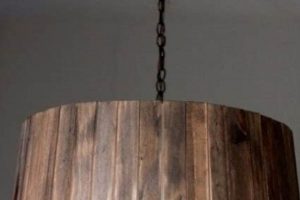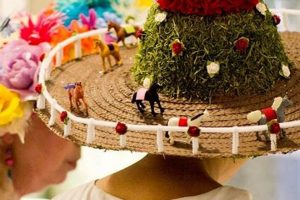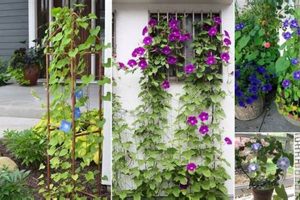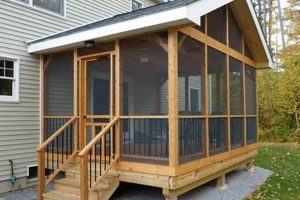The phrase signifies a range of creative concepts centered on constructing water features from readily available or repurposed materials. These projects empower individuals to design and build personalized outdoor or indoor decorative elements that incorporate moving water. For instance, a self-made water feature might utilize terracotta pots, a submersible pump, and some tubing to create a tiered cascading display.
The appeal of such endeavors stems from several factors, including cost-effectiveness, customization options, and the satisfaction of creating a unique landscape or home accent. Historically, water features have been associated with tranquility and aesthetic enhancement. Constructing them oneself allows for tailored integration into existing spaces, reflecting personal style and preferences, while potentially minimizing expense compared to purchasing pre-made alternatives.
The following article will delve into diverse approaches for realizing self-constructed water features, examining specific material choices, construction techniques, safety considerations, and the overall process of bringing these decorative enhancements to fruition. These include container options, pump selection, and potential customization through lighting or integrated planting.
Essential Considerations for Successful Water Feature Creation
Constructing a water feature requires careful planning and execution. The following guidelines offer essential insights for achieving a functional and aesthetically pleasing outcome.
Tip 1: Pump Selection: Prioritize selecting a submersible pump with appropriate flow rate (gallons per hour or liters per hour) for the intended feature’s size and design. Oversized pumps can lead to excessive splashing and noise, while undersized pumps may result in inadequate water circulation.
Tip 2: Liner Integrity: When using a flexible liner (e.g., PVC or EPDM), ensure proper installation to prevent leaks. Overlap seams generously and protect the liner from sharp objects or abrasion during installation and backfilling.
Tip 3: Water Level Management: Design the feature with an adequate reservoir to minimize water loss due to evaporation and splashing. Consider incorporating an automatic water fill system to maintain a consistent water level, particularly in warmer climates.
Tip 4: Filtration Implementation: Integrate a filtration system (mechanical and/or biological) to maintain water clarity and prevent algae growth. Regularly clean or replace filter media to ensure optimal performance and prevent pump damage.
Tip 5: Electrical Safety Protocols: Adhere strictly to electrical safety codes when installing and operating pumps and lighting. Utilize ground fault circuit interrupters (GFCIs) to protect against electrical shock hazards. Bury electrical cables in conduit and ensure proper grounding.
Tip 6: Material Compatibility: Choose materials that are non-toxic and compatible with aquatic environments. Avoid using materials that may leach harmful chemicals into the water, potentially harming plants or wildlife.
Tip 7: Location Considerations: Position the feature in a location that receives adequate sunlight (for plants, if applicable) and is easily accessible for maintenance. Avoid placing it directly under trees that may shed excessive leaves or debris into the water.
Careful attention to these details will contribute significantly to the longevity, functionality, and enjoyment derived from a self-constructed water element.
With these guidelines in mind, the following sections will explore detailed build process and design variations.
1. Material Selection
Material selection represents a foundational element within the scope of creating self-constructed water features. The chosen materials directly influence the aesthetic characteristics, structural integrity, and long-term durability of the project. An ill-considered selection can lead to premature failure, increased maintenance demands, or undesirable aesthetic outcomes. For example, using untreated wood in constant contact with water will invariably lead to rot and eventual collapse, whereas employing a naturally water-resistant material like stone or treated lumber extends the lifespan considerably. Therefore, comprehending material properties is crucial.
The impact of material choice extends beyond mere longevity. The visual character of a water feature is predominantly determined by its constituent elements. A contemporary design might incorporate stainless steel or glass for a sleek, minimalist appearance, while a rustic aesthetic could favor natural stone or reclaimed wood. The compatibility of materials is also paramount; dissimilar substances can react adversely when in constant contact with water, leading to corrosion or discoloration. A practical example involves using copper pipes in conjunction with galvanized steel fittings, which can accelerate galvanic corrosion and compromise the system’s integrity.
Ultimately, informed material selection is not merely an aesthetic consideration but a pragmatic imperative. Failure to account for material properties, compatibility, and environmental factors can result in costly repairs, diminished aesthetic appeal, and a reduced operational lifespan. Prioritizing research and careful evaluation of material options is essential for achieving a successful and enduring self-constructed water feature. This focus also emphasizes that the best approach to an individual idea of a fountain is the most well-researched and curated one.
2. Pump Specifications
Pump specifications represent a critical determinant of functionality within a self-constructed water feature. The pump’s capacity, measured in gallons per hour (GPH) or liters per hour (LPH), directly influences the water flow rate and the height to which water can be lifted. An inappropriately sized pump results in either inadequate water circulation, negating the aesthetic effect, or excessive splashing and potential system damage. For example, a multi-tiered water feature demands a pump with sufficient head pressure to elevate water to the uppermost tier; a pump lacking this capacity renders the design ineffective. The selection of pump specifications is therefore not arbitrary, but a calculated decision based on the specific requirements of the envisioned project.
Considering energy efficiency is also paramount. Submersible pumps operate continuously, thus their power consumption impacts operating costs. Inefficiencies in design or operation translate directly to higher electricity bills. Furthermore, the pump’s lifespan correlates with its quality and the operating conditions. Overstressing a pump through improper sizing or neglecting maintenance procedures shortens its service life, necessitating premature replacement. For instance, operating a pump continuously at its maximum capacity increases the likeliho
od of impeller wear or motor failure. Practical applications demand a thorough understanding of the relationship between flow rate, head pressure, power consumption, and anticipated usage patterns.
In summary, appropriate pump selection represents a fundamental prerequisite for successful implementation of a self-constructed water feature. Failing to address pump specifications adequately jeopardizes the intended aesthetic and operational characteristics, increasing the risk of system failure and incurring avoidable expenses. The challenge lies in accurately assessing the specific demands of the design and selecting a pump that effectively balances performance, energy efficiency, and long-term reliability. This aspect highlights the need for thorough research and informed decision-making during the planning phase of any water feature project.
3. Structural Integrity
Structural integrity forms a critical, often underappreciated, element within the framework of self-constructed water features. Its absence precipitates catastrophic failure, resulting in water loss, property damage, and potential safety hazards. When embarking on such a project, careful consideration must be given to load-bearing capacity, material stability under prolonged water exposure, and the overall design’s resistance to environmental stresses. A water feature, regardless of its aesthetic appeal, is fundamentally unsound without robust structural engineering, however basic. The cause-and-effect relationship is direct: inadequate support structures inevitably lead to collapse, while a well-engineered foundation ensures stability and longevity.
The importance of structural integrity manifests in numerous practical applications. For example, a tiered fountain constructed from stacked stones requires a solid base and appropriately sized stones to distribute weight evenly. Failure to account for these factors can lead to shifting, tilting, and eventual toppling of the structure. Similarly, a raised water feature constructed from wood must utilize pressure-treated lumber and adequate bracing to prevent warping, rotting, and structural weakening caused by constant moisture exposure. Real-life examples abound of DIY water features collapsing due to inadequate foundations, poorly joined components, or the use of inappropriate materials. The consequences often extend beyond mere aesthetic disappointment, potentially involving costly repairs and the risk of injury.
Understanding the practical significance of structural integrity translates directly into safer and more durable self-constructed water features. By prioritizing sound engineering principles, selecting appropriate materials, and employing robust construction techniques, individuals can mitigate the risk of structural failure and create visually appealing water features that withstand the test of time. The challenge lies in acquiring sufficient knowledge of basic structural concepts and applying them diligently throughout the design and construction process. A well-built water feature not only enhances its surroundings but also stands as a testament to the importance of structural integrity in DIY projects.
4. Waterproofing Methods
Effective waterproofing is paramount to the longevity and functionality of any self-constructed water feature. Leakage not only results in water loss but can also compromise the structural integrity of the surrounding environment, leading to costly repairs and potential damage. Therefore, the selection and application of appropriate sealing techniques are integral to the success of a do-it-yourself water feature project.
- Liner Selection and Installation
The use of flexible liners, such as PVC or EPDM rubber, provides a primary barrier against water loss. Proper installation, involving careful seaming and protection from punctures, is crucial. Overlapping seams and utilizing specialized adhesives ensures a watertight seal, preventing seepage into the surrounding soil and minimizing water consumption.
- Sealing Concrete and Masonry
Concrete and masonry elements require specific waterproofing treatments due to their porous nature. Applying a waterproof sealant, such as a penetrating concrete sealer or epoxy coating, prevents water absorption and potential freeze-thaw damage. Multiple coats may be necessary to achieve optimal protection, especially in regions with harsh climates.
- Joint and Seam Sealing
Any joints or seams within the water features structure represent potential points of weakness. Utilizing waterproof caulking or sealant, specifically designed for aquatic environments, prevents water migration through these areas. Regular inspection and maintenance of these seals are essential to maintaining a watertight barrier over time.
- Submersible Sealants and Adhesives
Components submerged within the water feature, such as pipes, fittings, and electrical connections, require specialized sealants and adhesives designed for continuous water exposure. These products must be non-toxic and resistant to degradation in aquatic environments to prevent contamination and ensure long-term functionality.
The application of appropriate waterproofing methods is an indispensable element of any self-constructed water feature. Neglecting this aspect undermines the project’s structural integrity and operational efficiency, potentially leading to significant problems down the line. Therefore, a comprehensive understanding and meticulous application of waterproofing techniques are essential for ensuring a successful and enduring outcome.
5. Aesthetic Customization
Aesthetic customization represents a pivotal component within the realm of self-constructed water features. It is the avenue through which individuals imbue these projects with personal style, transforming functional water systems into artistic expressions. The extent to which a fountain reflects the builder’s aesthetic preferences directly impacts its integration with the surrounding environment, be it a garden, patio, or interior space. Therefore, customization is not merely an optional embellishment but an integral element that shapes the overall impact of the finished project. Without deliberate customization, a DIY water feature risks appearing generic or incongruous with its intended setting.
The practical application of aesthetic customization manifests in diverse forms. Material selection, as previously discussed, plays a significant role, with choices ranging from natural stone to modern metals influencing the visual character. However, customization extends beyond materials to encompass design elements such as fountain shape, water flow patterns, lighting, and surrounding landscaping. For instance, a minimalist fountain featuring clean lines and a single, controlled water jet might complement a contemporary architectural style, while a rustic fountain adorned with pebbles and cascading waterfalls could enhance a naturalistic garden setting. Furthermore, the incorporation of plants, sculptures, or other decorative elements allows for further personalization, creating a water feature that is uniquely tailored to the individual’s
tastes. Real-world examples include fountains designed to mimic natural springs, fountains incorporating repurposed materials for an eco-conscious aesthetic, and fountains featuring intricate tile mosaics or custom-built sculptures.
In summary, aesthetic customization is inseparable from the concept of self-constructed water features. It is the key to transforming a functional water system into a cohesive and visually appealing element that reflects personal style and enhances its surroundings. The challenge lies in balancing aesthetic preferences with practical considerations such as budget, skill level, and the overall design’s compatibility with its intended environment. When approached thoughtfully, aesthetic customization elevates a simple water feature into a unique and personalized work of art.
6. Maintenance Protocols
Maintenance protocols represent an indispensable element inextricably linked to the long-term success of water features derived from fountain DIY ideas. These protocols dictate the operational lifespan, aesthetic appeal, and hygienic integrity of self-constructed water elements. The absence of established maintenance regimens invariably leads to problems such as algae accumulation, pump failure, clogged filters, and unsightly mineral deposits, diminishing the desired aesthetic and potentially rendering the feature inoperable. This cause-and-effect relationship underscores the essential role of maintenance in realizing the full potential of any DIY water feature endeavor. For instance, failure to regularly clean a fountain’s pump intake results in reduced flow and eventual burnout, a common occurrence in poorly maintained systems. Maintenance, therefore, is not an afterthought but a fundamental component of the initial design and construction process.
Effective maintenance protocols encompass several key areas: water quality management, pump and filter maintenance, and structural inspection. Water quality management involves regular water changes to reduce the buildup of organic matter and the use of appropriate algaecides or clarifying agents to maintain clarity. Pump and filter maintenance entails cleaning or replacing filter media, inspecting the pump for debris, and ensuring proper lubrication. Structural inspection identifies potential cracks, leaks, or deterioration in the feature’s construction materials, enabling timely repairs to prevent further damage. Consider a concrete fountain exposed to freezing temperatures; without proper sealing and drainage, water trapped within the concrete expands upon freezing, causing cracks and structural degradation. Consistent adherence to a well-defined maintenance schedule mitigates such risks, preserving the water feature’s structural integrity and aesthetic value over time.
In conclusion, a comprehensive understanding and diligent application of maintenance protocols are essential for maximizing the benefits derived from self-constructed water features. While the initial construction phase demands creativity and technical skill, the ongoing maintenance phase dictates the project’s long-term viability. The challenge lies in recognizing that DIY water features are not static installations but dynamic systems requiring continuous care and attention. Neglecting this fundamental aspect undermines the initial investment and ultimately detracts from the intended aesthetic and functional enjoyment. Prioritizing maintenance protocols ensures that the fountain remains a source of beauty and tranquility for years to come.
Frequently Asked Questions Regarding Self-Constructed Water Features
The following section addresses common inquiries concerning the design, construction, and maintenance of water features, providing clarity on potential challenges and offering practical solutions.
Question 1: What are the fundamental considerations when selecting a pump for a DIY fountain?
Pump selection necessitates careful evaluation of flow rate requirements, determined by the fountain’s size and desired water display. Furthermore, the pump’s head pressure rating, measured in feet or meters, must exceed the vertical distance the water needs to be lifted. Energy efficiency and long-term reliability are also essential factors influencing pump choice.
Question 2: How can algae growth be effectively controlled in a self-made water feature?
Algae control can be achieved through a multifaceted approach, including regular water changes, the introduction of aquatic plants that compete with algae for nutrients, and the use of commercially available algaecides specifically formulated for use in water features. Adequate filtration is also crucial in removing organic matter that fuels algae growth.
Question 3: What waterproofing methods are suitable for a concrete fountain constructed in a cold climate?
For concrete fountains exposed to freezing temperatures, a penetrating concrete sealer should be applied to prevent water absorption. Additionally, ensuring proper drainage and implementing a freeze-thaw resistant sealant in joints and seams mitigate the risk of cracking caused by ice expansion.
Question 4: Is it possible to build a water feature suitable for indoor environments?
Indoor water features are feasible, provided that precautions are taken to prevent water damage. Using a properly sealed basin, selecting a pump with minimal splashing, and ensuring adequate ventilation can minimize the risk of moisture-related problems. Consider also the potential for mineral buildup from tap water.
Question 5: What safety measures should be implemented when incorporating electrical components into a water feature?
Electrical safety is paramount. Ground Fault Circuit Interrupters (GFCIs) must be used to protect against electrical shock hazards. All electrical cables should be buried in conduit, and all connections should be watertight and comply with local electrical codes. Regular inspection of electrical components is also essential.
Question 6: How often should a self-constructed fountain be cleaned, and what is the recommended cleaning procedure?
The frequency of cleaning depends on environmental factors and water quality, but a general guideline is to clean the fountain every 2-4 weeks. This involves draining the water, scrubbing the basin to remove algae and mineral deposits, cleaning the pump and filter, and refilling the fountain with fresh water. Harsh chemicals should be avoided to prevent damage to the fountain’s components.
In summary, attention to pump selection, algae control, waterproofing, electrical safety, and regular maintenance practices are key to ensuring the successful implementation and long-term enjoyment of a self-constructed water feature.
Following the preceding discussion, the subsequent section will explore specific design variations and construction techniques.
Conclusion
The preceding discourse has detailed the multifaceted nature of fountain diy ideas, emphasizing the critical aspects of material selection, pump specifications, structural integrity, waterproofing methods, aesthetic customization, and maintenance protocols. Successful implementation of such projects hinges on a comprehensive understanding of these interconnected elements and their practical application.
Effective execution necessitates diligent planning, informed decision-making, and consistent maintenance. The enduring aesthetic and functional value of self-constructed water features justifies the investment of time and effort required to master these principles
. Further exploration and adherence to sound construction practices will ensure continued advancement in the realm of fountain diy ideas.




![Creative DIY Mobile Home Skirting Ideas [Guide] The DIY Hub: Creative Crafts, Repairs & Life Hacks Creative DIY Mobile Home Skirting Ideas [Guide] | The DIY Hub: Creative Crafts, Repairs & Life Hacks](https://craftingdiycenter.com/wp-content/uploads/2025/07/th-4605-300x200.jpg)


